lock FIAT DUCATO BASE CAMPER 2015 Owner handbook (in English)
[x] Cancel search | Manufacturer: FIAT, Model Year: 2015, Model line: DUCATO BASE CAMPER, Model: FIAT DUCATO BASE CAMPER 2015Pages: 367, PDF Size: 19.73 MB
Page 204 of 367
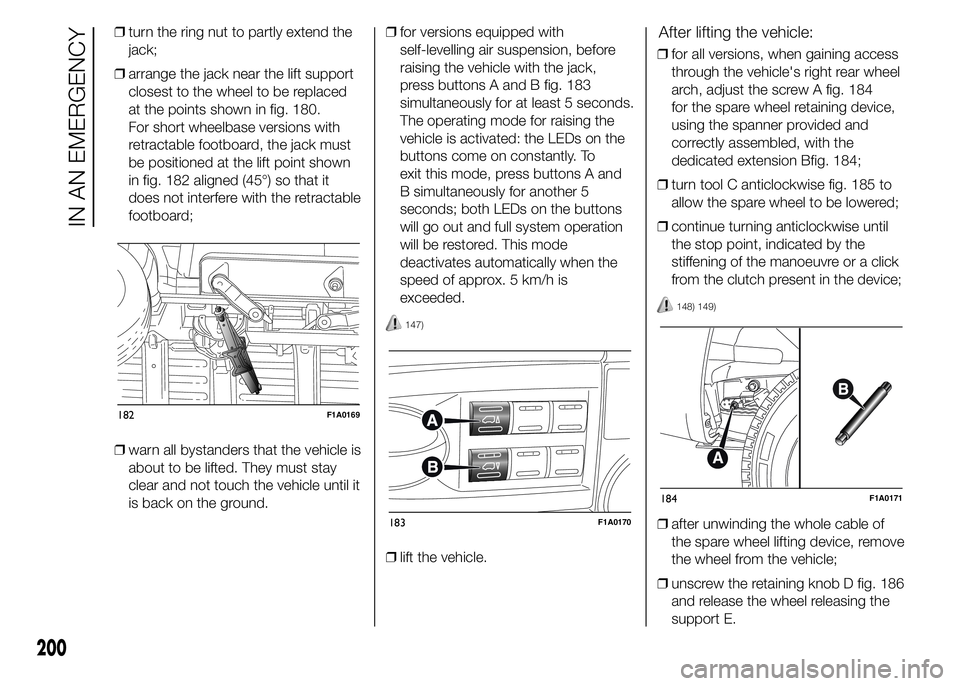
❒turn the ring nut to partly extend the
jack;
❒arrange the jack near the lift support
closest to the wheel to be replaced
at the points shown in fig. 180.
For short wheelbase versions with
retractable footboard, the jack must
be positioned at the lift point shown
in fig. 182 aligned (45°) so that it
does not interfere with the retractable
footboard;
❒warn all bystanders that the vehicle is
about to be lifted. They must stay
clear and not touch the vehicle until it
is back on the ground.❒for versions equipped with
self-levelling air suspension, before
raising the vehicle with the jack,
press buttons A and B fig. 183
simultaneously for at least 5 seconds.
The operating mode for raising the
vehicle is activated: the LEDs on the
buttons come on constantly. To
exit this mode, press buttons A and
B simultaneously for another 5
seconds; both LEDs on the buttons
will go out and full system operation
will be restored. This mode
deactivates automatically when the
speed of approx. 5 km/h is
exceeded.
147)
❒lift the vehicle.
After lifting the vehicle:
❒for all versions, when gaining access
through the vehicle's right rear wheel
arch, adjust the screw A fig. 184
for the spare wheel retaining device,
using the spanner provided and
correctly assembled, with the
dedicated extension Bfig. 184;
❒turn tool C anticlockwise fig. 185 to
allow the spare wheel to be lowered;
❒continue turning anticlockwise until
the stop point, indicated by the
stiffening of the manoeuvre or a click
from the clutch present in the device;
148) 149)
❒after unwinding the whole cable of
the spare wheel lifting device, remove
the wheel from the vehicle;
❒unscrew the retaining knob D fig. 186
and release the wheel releasing the
support E.
182F1A0169
183F1A0170
184F1A0171
200
IN AN EMERGENCY
Page 205 of 367

❒with the assembled tools, completely
loosen the bolts fig. 187 and remove
the wheel;
❒fit the spare wheel, aligning holes G
fig. 188 with the pins H. When fitting
the spare wheel, ensure that the
wheel support surfaces are clean and
free of impurities that could
subsequently cause the bolts to
loosen;
❒screw in the 5 fastening bolts;❒assemble the tools to fully tighten the
bolts, passing alternately from one
bolt to the one diametrically opposite,
following the order illustrated in fig.
188;
❒use the wheel removal wrench to
lower the vehicle and remove the
jack;
At the end of the operation:
❒take the removed wheel, re-attach it
to the mount E fig. 186 and tighten
the knob D;❒introduce the assembled tool fig. 185
with the suitable extension B fig. 184
on the screw A fig. 184 of the spare
wheel housing manoeuvring device
and turn clockwise to lift the spare
wheel back up until it is fully
supported in its housing under the
platform, checking that the
attachment reference D fig. 185
appears in the window on the device;
150)
For vehicles with alloy rims,
proceed as follows:
❒carry out the above described
operations for changing the wheel
until loading the punctured wheel on
the spare wheel lifting device;
185F1A0421
186F1A0174
187F1A0422
G
H
188F1A0176
189F1A0430
201
Page 206 of 367
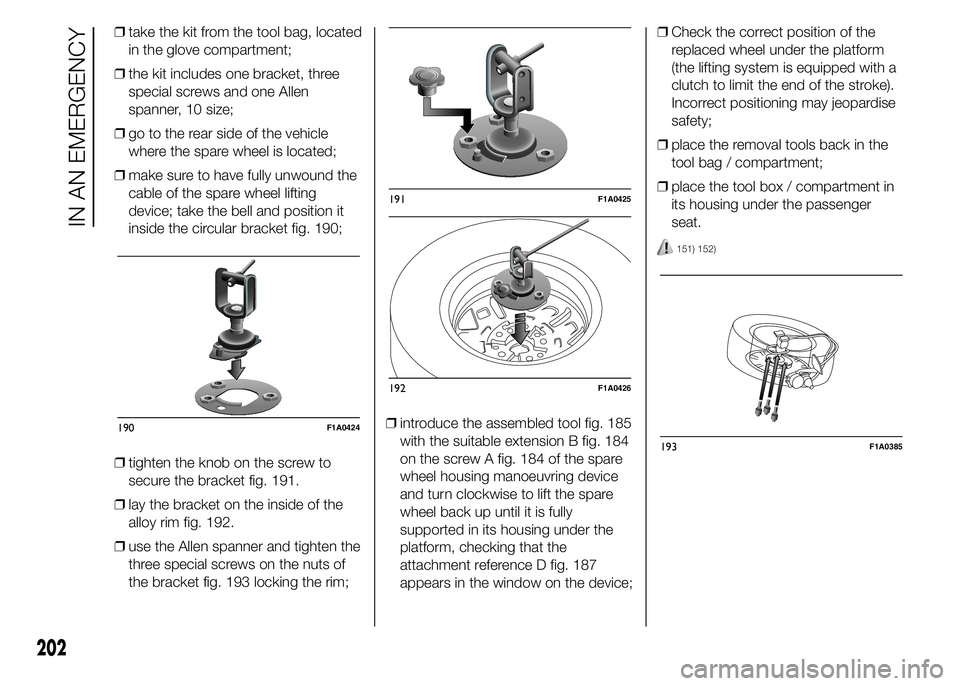
❒take the kit from the tool bag, located
in the glove compartment;
❒the kit includes one bracket, three
special screws and one Allen
spanner, 10 size;
❒go to the rear side of the vehicle
where the spare wheel is located;
❒make sure to have fully unwound the
cable of the spare wheel lifting
device; take the bell and position it
inside the circular bracket fig. 190;
❒tighten the knob on the screw to
secure the bracket fig. 191.
❒lay the bracket on the inside of the
alloy rim fig. 192.
❒use the Allen spanner and tighten the
three special screws on the nuts of
the bracket fig. 193 locking the rim;❒introduce the assembled tool fig. 185
with the suitable extension B fig. 184
on the screw A fig. 184 of the spare
wheel housing manoeuvring device
and turn clockwise to lift the spare
wheel back up until it is fully
supported in its housing under the
platform, checking that the
attachment reference D fig. 187
appears in the window on the device;❒Check the correct position of the
replaced wheel under the platform
(the lifting system is equipped with a
clutch to limit the end of the stroke).
Incorrect positioning may jeopardise
safety;
❒place the removal tools back in the
tool bag / compartment;
❒place the tool box / compartment in
its housing under the passenger
seat.
151) 152)
190F1A0424
191F1A0425
192F1A0426
193F1A0385
202
IN AN EMERGENCY
Page 207 of 367
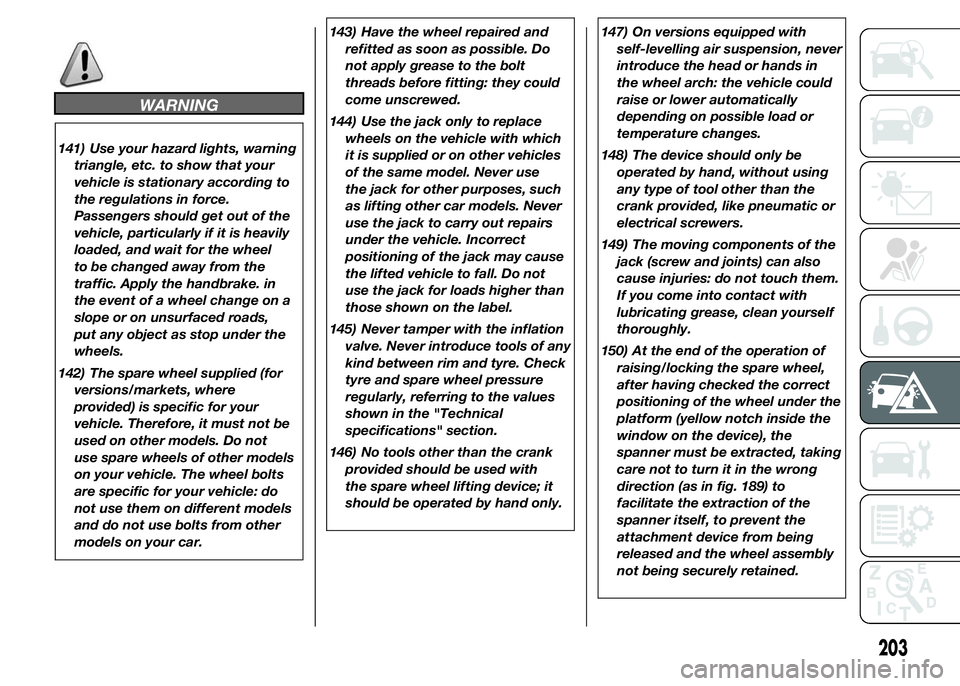
WARNING
141) Use your hazard lights, warning
triangle, etc. to show that your
vehicle is stationary according to
the regulations in force.
Passengers should get out of the
vehicle, particularly if it is heavily
loaded, and wait for the wheel
to be changed away from the
traffic. Apply the handbrake. in
the event of a wheel change on a
slope or on unsurfaced roads,
put any object as stop under the
wheels.
142) The spare wheel supplied (for
versions/markets, where
provided) is specific for your
vehicle. Therefore, it must not be
used on other models. Do not
use spare wheels of other models
on your vehicle. The wheel bolts
are specific for your vehicle: do
not use them on different models
and do not use bolts from other
models on your car.143) Have the wheel repaired and
refitted as soon as possible. Do
not apply grease to the bolt
threads before fitting: they could
come unscrewed.
144) Use the jack only to replace
wheels on the vehicle with which
it is supplied or on other vehicles
of the same model. Never use
the jack for other purposes, such
as lifting other car models. Never
use the jack to carry out repairs
under the vehicle. Incorrect
positioning of the jack may cause
the lifted vehicle to fall. Do not
use the jack for loads higher than
those shown on the label.
145) Never tamper with the inflation
valve. Never introduce tools of any
kind between rim and tyre. Check
tyre and spare wheel pressure
regularly, referring to the values
shown in the "Technical
specifications" section.
146) No tools other than the crank
provided should be used with
the spare wheel lifting device; it
should be operated by hand only.147) On versions equipped with
self-levelling air suspension, never
introduce the head or hands in
the wheel arch: the vehicle could
raise or lower automatically
depending on possible load or
temperature changes.
148) The device should only be
operated by hand, without using
any type of tool other than the
crank provided, like pneumatic or
electrical screwers.
149) The moving components of the
jack (screw and joints) can also
cause injuries: do not touch them.
If you come into contact with
lubricating grease, clean yourself
thoroughly.
150) At the end of the operation of
raising/locking the spare wheel,
after having checked the correct
positioning of the wheel under the
platform (yellow notch inside the
window on the device), the
spanner must be extracted, taking
care not to turn it in the wrong
direction (as in fig. 189) to
facilitate the extraction of the
spanner itself, to prevent the
attachment device from being
released and the wheel assembly
not being securely retained.
203
Page 209 of 367
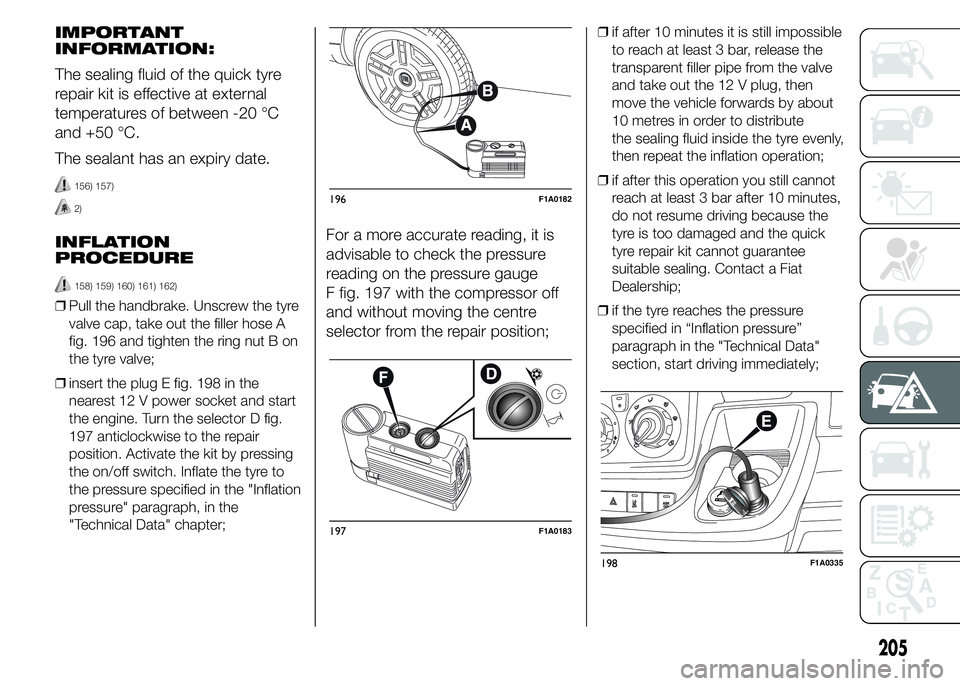
IMPORTANT
INFORMATION:
The sealing fluid of the quick tyre
repair kit is effective at external
temperatures of between -20 °C
and +50 °C.
The sealant has an expiry date.
156) 157)
2)
INFLATION
PROCEDURE
158) 159) 160) 161) 162)
❒Pull the handbrake. Unscrew the tyre
valve cap, take out the filler hose A
fig. 196 and tighten the ring nut B on
the tyre valve;
❒insert the plug E fig. 198 in the
nearest 12 V power socket and start
the engine. Turn the selector D fig.
197 anticlockwise to the repair
position. Activate the kit by pressing
the on/off switch. Inflate the tyre to
the pressure specified in the "Inflation
pressure" paragraph, in the
"Technical Data" chapter;
For a more accurate reading, it is
advisable to check the pressure
reading on the pressure gauge
F fig. 197 with the compressor off
and without moving the centre
selector from the repair position;
❒if after 10 minutes it is still impossible
to reach at least 3 bar, release the
transparent filler pipe from the valve
and take out the 12 V plug, then
move the vehicle forwards by about
10 metres in order to distribute
the sealing fluid inside the tyre evenly,
then repeat the inflation operation;
❒if after this operation you still cannot
reach at least 3 bar after 10 minutes,
do not resume driving because the
tyre is too damaged and the quick
tyre repair kit cannot guarantee
suitable sealing. Contact a Fiat
Dealership;
❒if the tyre reaches the pressure
specified in “Inflation pressure”
paragraph in the "Technical Data"
section, start driving immediately;
196F1A0182
197F1A0183
198F1A0335
205
Page 210 of 367
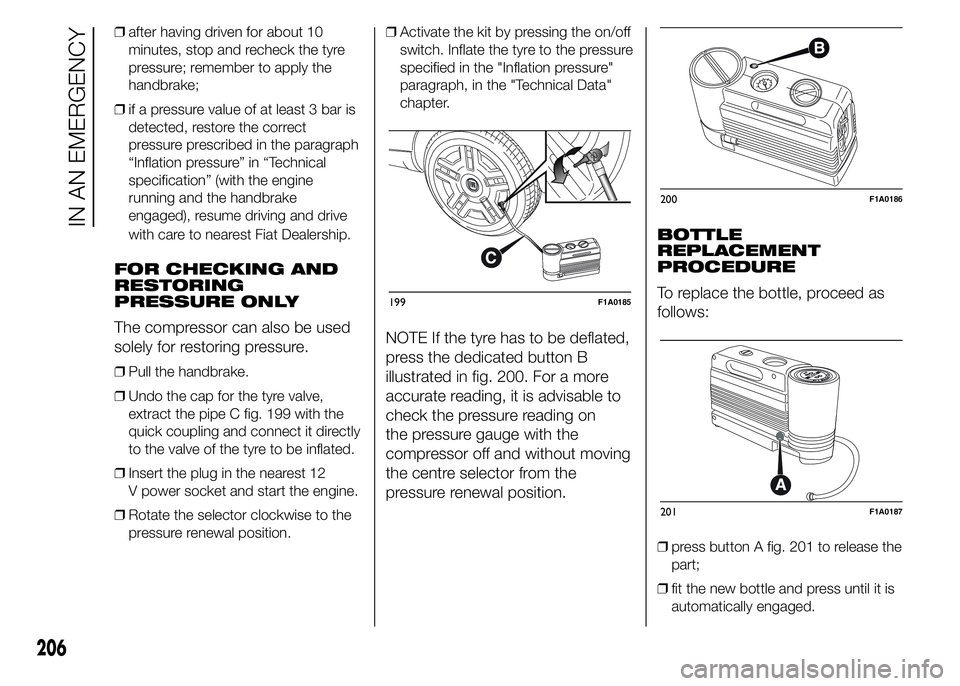
❒after having driven for about 10
minutes, stop and recheck the tyre
pressure; remember to apply the
handbrake;
❒if a pressure value of at least 3 bar is
detected, restore the correct
pressure prescribed in the paragraph
“Inflation pressure” in “Technical
specification” (with the engine
running and the handbrake
engaged), resume driving and drive
with care to nearest Fiat Dealership.
FOR CHECKING AND
RESTORING
PRESSURE ONLY
The compressor can also be used
solely for restoring pressure.
❒Pull the handbrake.
❒Undo the cap for the tyre valve,
extract the pipe C fig. 199 with the
quick coupling and connect it directly
to the valve of the tyre to be inflated.
❒Insert the plug in the nearest 12
V power socket and start the engine.
❒Rotate the selector clockwise to the
pressure renewal position.❒Activate the kit by pressing the on/off
switch. Inflate the tyre to the pressure
specified in the "Inflation pressure"
paragraph, in the "Technical Data"
chapter.
NOTE If the tyre has to be deflated,
press the dedicated button B
illustrated in fig. 200. For a more
accurate reading, it is advisable to
check the pressure reading on
the pressure gauge with the
compressor off and without moving
the centre selector from the
pressure renewal position.BOTTLE
REPLACEMENT
PROCEDURE
To replace the bottle, proceed as
follows:
❒press button A fig. 201 to release the
part;
❒fit the new bottle and press until it is
automatically engaged.
199F1A0185
200F1A0186
201F1A0187
206
IN AN EMERGENCY
Page 213 of 367
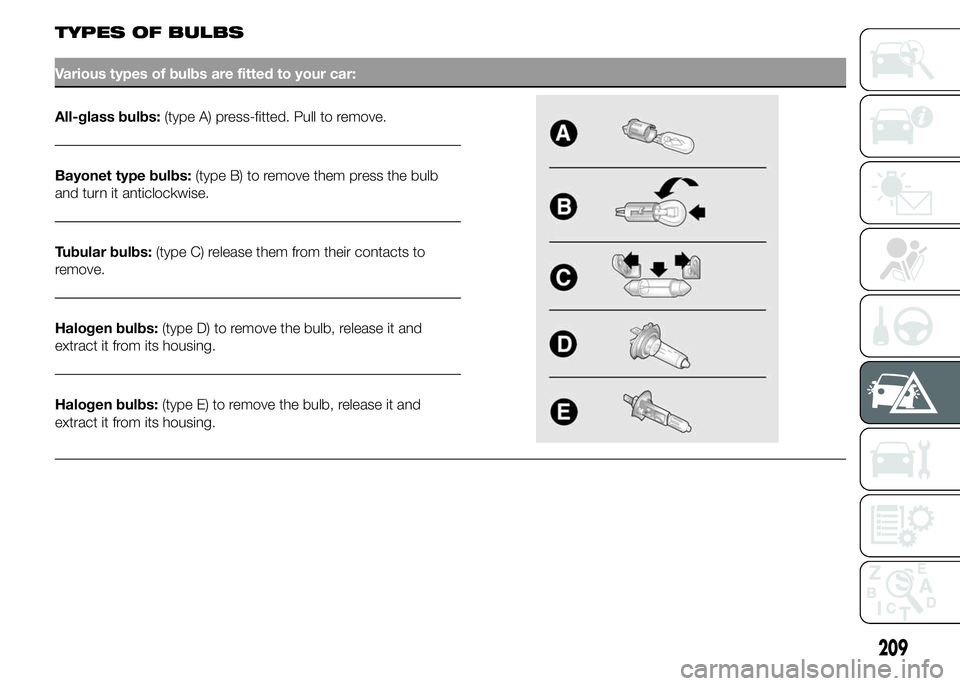
TYPES OF BULBS
Various types of bulbs are fitted to your car:
All-glass bulbs:(type A) press-fitted. Pull to remove.
Bayonet type bulbs:(type B) to remove them press the bulb
and turn it anticlockwise.
Tubular bulbs:(type C) release them from their contacts to
remove.
Halogen bulbs:(type D) to remove the bulb, release it and
extract it from its housing.
Halogen bulbs:(type E) to remove the bulb, release it and
extract it from its housing.
209
Page 215 of 367
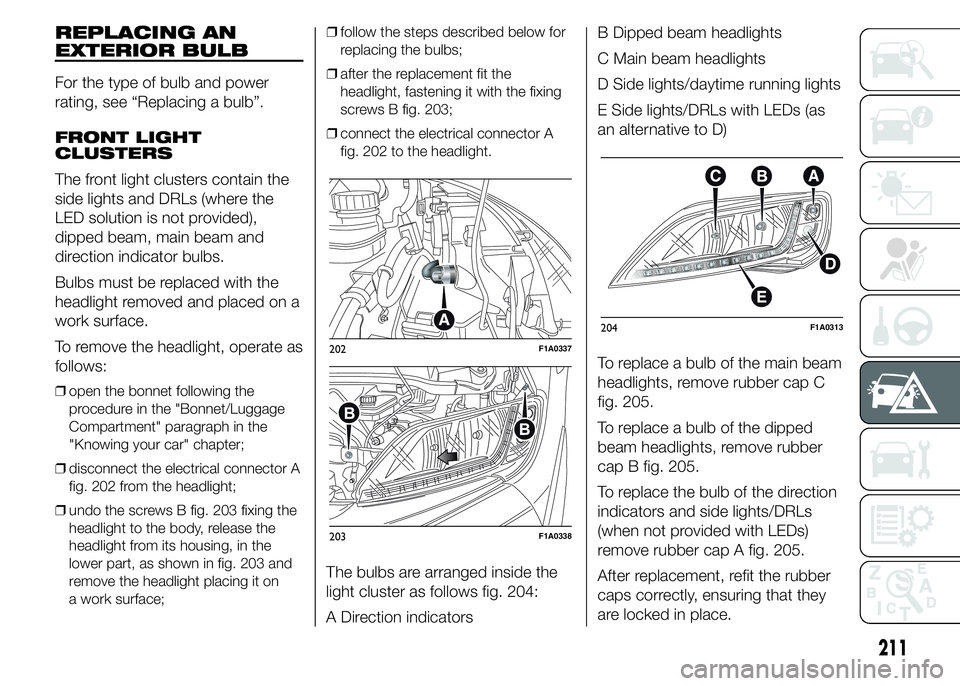
REPLACING AN
EXTERIOR BULB
For the type of bulb and power
rating, see “Replacing a bulb”.
FRONT LIGHT
CLUSTERS
The front light clusters contain the
side lights and DRLs (where the
LED solution is not provided),
dipped beam, main beam and
direction indicator bulbs.
Bulbs must be replaced with the
headlight removed and placed on a
work surface.
To remove the headlight, operate as
follows:
❒open the bonnet following the
procedure in the "Bonnet/Luggage
Compartment" paragraph in the
"Knowing your car" chapter;
❒disconnect the electrical connector A
fig. 202 from the headlight;
❒undo the screws B fig. 203 fixing the
headlight to the body, release the
headlight from its housing, in the
lower part, as shown in fig. 203 and
remove the headlight placing it on
a work surface;❒follow the steps described below for
replacing the bulbs;
❒after the replacement fit the
headlight, fastening it with the fixing
screws B fig. 203;
❒connect the electrical connector A
fig. 202 to the headlight.
The bulbs are arranged inside the
light cluster as follows fig. 204:
A Direction indicatorsB Dipped beam headlights
C Main beam headlights
D Side lights/daytime running lights
E Side lights/DRLs with LEDs (as
an alternative to D)
To replace a bulb of the main beam
headlights, remove rubber cap C
fig. 205.
To replace a bulb of the dipped
beam headlights, remove rubber
cap B fig. 205.
To replace the bulb of the direction
indicators and side lights/DRLs
(when not provided with LEDs)
remove rubber cap A fig. 205.
After replacement, refit the rubber
caps correctly, ensuring that they
are locked in place.
202F1A0337
203F1A0338
204F1A0313
211
Page 216 of 367

SIDE LIGHTS/DAYTIME
RUNNING LIGHTS
(LEDs)
These are LEDs. For replacement,
contact a Fiat Dealership.
SIDE LIGHTS/DAYTIME
RUNNING LIGHTS
To replace the bulb, proceed as
follows:
❒remove the protective rubber cover A
fig. 205;
❒turn the bulb holder B fig. 206
anticlockwise;
❒extract the bulb by pulling and
replace it;
❒remove the bulb by pushing it slightly
and turning it anticlockwise (bayonet
mount);❒refit the bulb holder B by turning it
clockwise and making sure that it
locks correctly
❒refit the protective rubber cover A fig.
205.
MAIN BEAM
HEADLIGHTS
To replace the bulb, proceed as
follows:
❒remove the protective rubber cover C
fig. 205;❒release the bulb holder A fig. 207
from the side clips B and remove it;
❒disconnect the electrical connector;
❒fit the new bulb, ensuring that the
outline of the metal part coincides
with the grooves on the curve of the
headlight, pressing to engage it
with the side clips;
❒reconnect the electrical connector;
❒refit the protective rubber cover C fig.
205.
DIPPED HEADLIGHTS
With incandescent
bulbs
To replace the bulb, proceed as
follows:
205F1A0314
206F1A0386
207F1A0315
208F1A0316
212
IN AN EMERGENCY
❒remove the protective rubber cover B
fig. 205;
Page 217 of 367
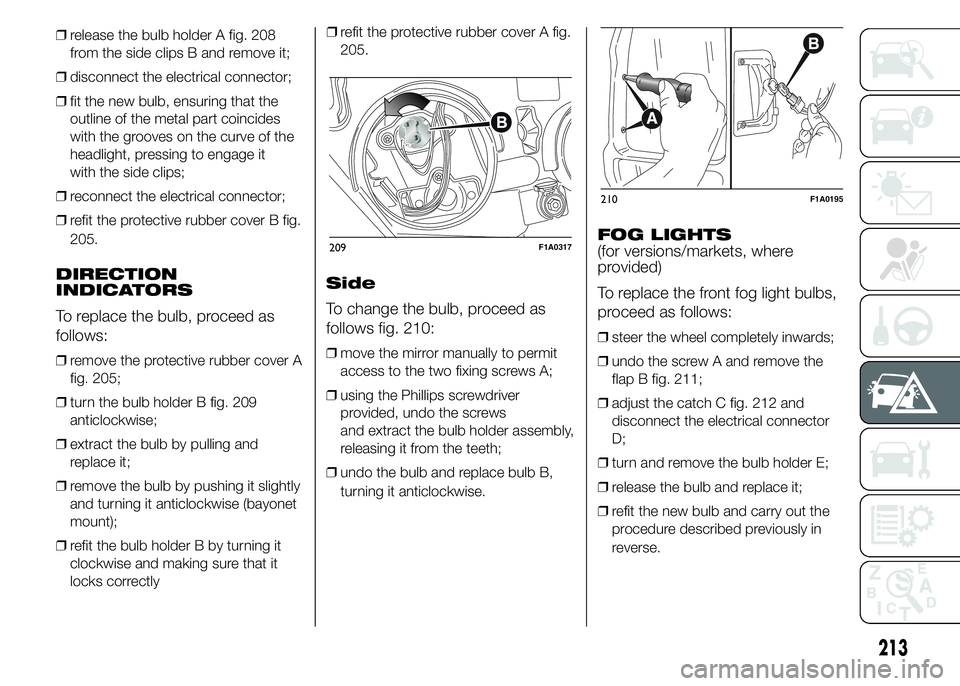
❒release the bulb holder A fig. 208
from the side clips B and remove it;
❒disconnect the electrical connector;
❒fit the new bulb, ensuring that the
outline of the metal part coincides
with the grooves on the curve of the
headlight, pressing to engage it
with the side clips;
❒reconnect the electrical connector;
❒refit the protective rubber cover B fig.
205.
DIRECTION
INDICATORS
To replace the bulb, proceed as
follows:
❒remove the protective rubber cover A
fig. 205;
❒turn the bulb holder B fig. 209
anticlockwise;
❒extract the bulb by pulling and
replace it;
❒remove the bulb by pushing it slightly
and turning it anticlockwise (bayonet
mount);
❒refit the bulb holder B by turning it
clockwise and making sure that it
locks correctly❒refit the protective rubber cover A fig.
205.
Side
To change the bulb, proceed as
follows fig. 210:
❒move the mirror manually to permit
access to the two fixing screws A;
❒using the Phillips screwdriver
provided, undo the screws
and extract the bulb holder assembly,
releasing it from the teeth;
❒undo the bulb and replace bulb B,
turning it anticlockwise.
FOG LIGHTS
(for versions/markets, where
provided)
To replace the front fog light bulbs,
proceed as follows:
❒steer the wheel completely inwards;
❒undo the screw A and remove the
flap B fig. 211;
❒adjust the catch C fig. 212 and
disconnect the electrical connector
D;
❒turn and remove the bulb holder E;
❒release the bulb and replace it;
❒refit the new bulb and carry out the
procedure described previously in
reverse.
209F1A0317
210F1A0195
213